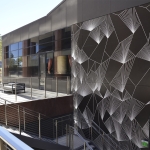In today’s world, the importance of accessibility and inclusivity cannot be emphasized more. Compliance with the Americans with Disabilities Act (ADA) guidelines is an effective way towards fulfilling these two important parameters during signage creation and installation in public places. ADA-compliant signage ensures equal access to all people. Even disabled persons can navigate the public places easily.
In this blog post, we will discuss the importance of adhering to ADA guidelines for signage designing and installing in public places. We will also talk about environmental graphics with a strong focus on how they can convey your brand-related information while ensuring an enhanced visual appeal.
The Importance of ADA Compliant Signage:
It is essential to comply with ADA guidelines when designing and installing signage in public spaces. It ensures that people with disabilities can access information and navigate public spaces safely and without barriers. The regulations specify the size, location, contrast, readability, and braille requirements for signs. Noncompliant signage may result in penalties and legal liabilities, and it is a social responsibility to ensure that all people can access information equally.
The Benefits of ADA Compliant Signage:
Apart from meeting legal requirements, ADA compliant signage offers several benefits. When signage is easy to read and comprehend, it reduces confusion and saves time. This benefit translates into higher customer satisfaction and helps create a positive impression. ADA compliant signage in public spaces also promotes inclusivity and diversity, raising social awareness of disabilities and leading to a more welcoming and tolerant society.
Environmental Graphics:
Environmental graphics are an effective way of enhancing the visual appeal of public spaces while conveying information and branding. They include signs, visual displays, murals, and installations that transform spaces into immersive, memorable environments that engage and inspire people. Environmental graphics serve several purposes, from wayfinding and communication to brand reinforcement and storytelling. They help create unique and memorable experiences, improve customer retention, boost employee morale, and promote social awareness and community engagement.
The Benefits of Environmental Graphics:
Environmental graphics offer several benefits. They are versatile and can be customized to meet individual needs and design aesthetics. They can highlight and reinforce the branding of a business, organization, or public space and act as a powerful marketing tool. Environmental graphics can also boost staff morale by creating a visually inspiring and stimulating work environment. Designing and installing environmental graphics are cost-effective ways of revitalizing public spaces, creating visual interest, and enhancing the user experience.
Conclusion:
Designing and installing signage and environmental graphics that are ADA compliant is more than a legal requirement; it’s a social responsibility. Creating and maintaining an inclusive, welcoming environment promotes diversity, improves customer satisfaction, and fosters social awareness. Complying with ADA guidelines is a fundamental step in achieving this goal and ensuring that all people can access information and navigate public spaces safely and comfortably. Environmental graphics complement and enhance the visual appeal of public spaces and offer numerous benefits. They are a cost-effective way of revitalizing public spaces, creating visual interest, and enhancing brand awareness. So, let’s strive to design and install signage and environmental graphics that promote inclusivity, diversity, and solidarity.




